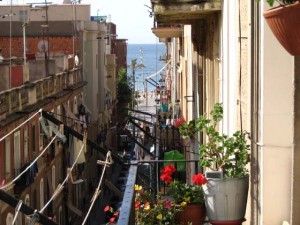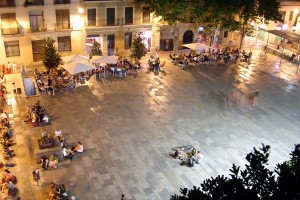A run-down of Barcelona barrios (neighborhoods)
One question I get a lot is “Where should I live in Barcelona?” to which my answer is: It depends. It depends on your lifestyle, what you are willing to pay, and which conveniences you need and the inconveniences you are willing to put up with. Do you want cheap rent? A swanky pad? To be in the middle of the action? peace and quiet? Barcelona offers everything you are looking for and they are all in different areas.
Note: If you are looking for short term accommodation–a couple of weeks to a couple of months–check the short term accommodation resources. If you’d like to look immediately for long term accommodation, including shared flats or student housing, check the long term rentals map page.
So let’s begin our tour with the city center, AKA Ciutat Vella, which is probably where your first place will be, and is comprised of four barrios:
Barrio Gotico
All the great history of Barcelona is right here, complete with Roman ruins glassed off in the middle of markets, banks, parks or just incorporated into the stone of newer (though still plenty old) buildings. Winding, ancient streets to get lost in and charming, modernist era bakeries and cafes, this is where all the tourists go to experience the history of the old Roman city or to get lost in the “European experience”.
Most expats choose to make this their first home in Barcelona, electing to move out after a year or two to get away from the noise of too-close neighbors, non-stop construction, vomiting tourists and the stench of pee. Still, it remains charming and exceptionally convenient, and if you can score decent terrace, you may choose to stay.
Barceloneta
An old fishing village on the beach, constructed as seasonal housing for fisherman, so they are tiny, one room affairs stacked high and featuring the tiniest of balconies. Renovation, however, has created some real gems–full of light and with terraces to die for–but you’ll have to pay for these. Plenty of expats and immigrants live in these rows of simple flats and spend a lot of time in the shared community plazas, indeed, the smallness of these pisos require most ground floor residents to dry their laundry on the sidewalk. It’s generally a higher (organized) petty crime area, though primarily with drug dealing as there is a nearly 0% violent crime rate in all of Barcelona. Barceloneta is a party place and is great for singles who want to be near the beach.
El Borne
AKA The Born. This used to be everyone’s second favorite barrio because of the many bars, good restaurants, high end fashion bargains, chill cafes and indie atmosphere. But tourism and crime is making its mark and expats are moving out. It’s part of the ancient city, and still very vibrant.
El Raval
A seedy, though relatively safe, barrio in the shadow of Montjuic, Raval is the home of many middle Asian immigrants which makes it the best place in Barcelona to find delicious, cheap Middle Eastern food. Musicians love Raval, it is jammed with bars and music venues, mostly smaller in size, but all of them feel like you have discovered a new treasure when you wander into a new place you never noticed before. The neighborhood has hundreds of years of history with gangs, drugs and prostitution. Within the last decade or so, Raval has (to the dismay of some) cleaned itself up though but it still isn’t a tourist area, though the city is trying to promote it as such. The prostitutes at every crossroads (most of which cars cannot fit through) still scare the tourists away.
L’Eixample
The Expansion of Barcelona, known more commonly as L’Eixample in Catalan. Pronounced, “ey-sham-pla”, it’s a massive grid of a city enlargement carried out in the1890s, connecting the Gotic area to the nearby pueblo of Gracia. It has a downtown metropolitan feel as opposed to an ancient Roman city feel…because it was designed to be a modern neighborhood. This higher end area was built in the industrial revolution and the start of the Modernist era, so there are many beautiful, Art Nouveau doorways and façades. It is somewhat lacks a community feel that the much more intimate (sometimes too intimate) closeness of the older parts of the old city offer, and also lacks the great plazas and open areas that the rest of Barcelona has, but it does host some good shopping, upscale bars and great restaurants. Eixample is divided into the izquierda (left) and derecha (right), with izquierda considered the higher (and therefore more expensive) end.
Gracia
This tends to be everyone’s favorite barrio. It’s full of hipsters, chic expats, artists, minimalists and even okupantes-the separatist squatters who sport dreadlocked mullets (girls included) and live off the government (or their parents). Originally a totally separate city from Barcelona until the Eixample connected the two cities, this ancient town has all the charm of the center without the smell. While you won’t find many ascensors (elevators/lifts) in any apartment block (there just isn’t space), the buildings rarely rise above three stories and many of them have been renovated or even made into lofts. It is relatively confusing for tourists to get to—the two metro stops are on the very outskirts of the barrio—but this helps Gracia remain unjaded and very much a locals haunt. Its main pedestrian street hosts a version original (original language version) cinema for those who can’t tolerate movies dubbed into Spanish (like me!) and the surrounding streets are full of quirky boutiques, ecological bakeries, cool cafes in beautiful plazas, wine bars and modern restaurants. The one and only drawback is its distance to the beaches, but the place is so charming you won’t care. And Barcelona is so small anyway, you can ride Bicing to the beach from there (it’s all downhill). This is the second place you will live, and when you move on to your third, you will think back on your year in Gracia with fondness.
Poble Sec
Butting up against Montjuic, and actually partially up the mountain, is the barrio of Poble Sec, Raval’s next door neighbor. This is a well connected area via metro and roads that you can actually drive on, right in the Montjuic area which is great for jogging, museum visiting, events and all kinds of outdoor things. I love climbing up it with my mountain bike and then riding around the trails at the top. In recent years, this barrio is the new hot spot and now offers plenty of worthwhile restaurants and bars of all types. Just have a look at Yelp and make a decision. Poble Sec has plenty of green areas and is a quieter neighborhood than most city center barrios. It’s also a very “Spanish” barrio, in that there is plenty of chatting with the lady at the bakery, the man who runs the liquor store and the sellers at the market.
Sants
A slightly cheaper area that has an “industrial park” with a green concrete lake, though the park is used as a park, with people playing sports and old people sitting around on the benches. The main train station is also here, which does mean traffic. However, down the smaller streets you’ll find lovely plazas, older buildings and a community feel. This area has everything, and while in the past it fell into disrepair, the city seems to be dedicating more money and effort to parks and community areas. This has also recently become the new gay area, so it is slowly getting beautified. It sits right above Plaza España, which offers Fira Convention center in and the new 5 level shopping center that was once Barcelona’s bullring (bull fighting is illegal in Catalunya, hence their symbol is the donkey, not the bull like the rest of Spain).
Les Corts
Just about Sant is les Corts. This is where the famous FGC Barcelona stadium, Camp Nou, is. This is a newer area, and thus has more car traffic than older areas: streets are wider, parking is more plentiful (though never outright plentiful) but lacking somewhat in charm in my opinion. This is one of the areas where wealthy Catalans come from their homes outside the city to shop. This also hosts the Polytechnic University just above a nice park, Parc de Pedralbes, which contains the former residence of the Spanish royal family.
Sarriá and Sant Gervasi
Sarriá and Sant Gervasi are wealthy barrios heading up the hill from L’Eixample. There are plenty of green areas, wide streets, trees and parks and wide walking ramblas (the Spanish love their ramblas). Sarriá used to be its own barrio, though not as old as Gracia, so it’s got a cool pueblo feel to it. They are both devoid of tourism as they are just nice, expensive, quiet areas. They do have the Ferro Carrils which are short distance trains that go downtown and connect to the metros. It is interesting to note that the further you get from the beach, the more expensive the areas get.
Poble Nou
All the way on the other side of town is Poble Nou, ‘new town’ in Catalan and pronounced “pob-la no,” is a study in contrasts. This is an old industrial district with brick warehouses and factories that have either been turned into trendy lofts, or left to crumble. Many an old factory are still waiting for reconstruction and plenty of gitanos (gypsies) make their homes in them, or in the places they used to stand- there are a grip of vacant lots around with a old brick wall left alone in the middle of them, next to a beautiful new construction of desirable flats. Smoke stacks, with the buildings they once supported completely torn down, stand alone in the middle of parks or plazas. Poble Nou has seen the most new construction of any barrio in Barcelona. The barrio is the hot new trendy place to live, with a great main street that goes from Diagonal directly to the beach, plenty of decent restaurants and zero tourism.
Horta-Giunardó
In the North-Eastern corner of Barcelona is the Horta-Guinardo district. Not a popular place for expats, because it is far from the beach and is extremely hilly. Until the last decades of the last century the area was occupied by fields, quarries, pastures and farmhouses, including Mas Guinardó which gave the neighborhood its name. Housing on the hillsides was mostly built in the 1960s and 70s, when immigrant workers were encouraged to move to Spain by Franco. Rents are cheap, though there isn’t exactly a bustling nightlife as the population seems to still be those immigrants that moved there in the 60s and 70s. But I like this area for its old charm and total lack of tourism. There are several remarkable things in this area, including a velodrome and a hilltop that features a lookout where the remains of an anti-aircraft lookout (complete with gun) from the Spanish civil war sits on a site where a shanty village was later constructed and only recently razed.
Outside Barcelona
The outskirts of Barcelona offers cities such as Sitges, a favorite for retired European gay couples with money and British families. Go figure. It’s a cute little beach town that was formerly a fishing village. It became a trendy place to live when the Catalan bourgeoisie began building their summer homes in Sitges in the 19th century. Great nightlife (though most of the clubs and bars are gay). As you can imagine, there is an amazing Mardi Gras parade here every year.
Finally, back to the other side of Barcelona, where the outskirts are Besos and further north, Badalona. This is where the Andalusian-Galician Spaniard immigrated in the 1960s and 70s: Now it’s a mix of Latin American, Pakistani, Chinese and Eastern Europe immigrants living alongside the adult children of the Southern Spanish immigrants. Badalona has also undergone a recent gentrification, on the beach fronts anyway, and you will generally fine cleaner, less crowded beaches that are still plenty lively. Everything is cheaper too: rent, restaurants, services. The major deterrent from living here–and most points north up to nearly Girona–are the train tracks that split the beach from the beach front property in most areas.
You likely won’t be looking to live beyond the metropolitan area, unless you want some land for animals, grapes, or an otherwise quiet rural life, which is likely not the reason you are moving here in the first place, though it may be where you end up ten years from now.









